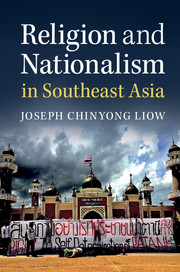Book contents
- Frontmatter
- Dedication
- Contents
- Preface
- Acknowledgments
- Glossary
- Introduction
- 1 Faith and Flag
- 2 Southern Philippines: Reframing Moro Nationalism from (Bangsa) Moro to Bangsamoro
- 3 Thailand's Southern Border Provinces: Constructing Narratives and Imagining Patani Darussalam
- 4 Malaysia: Religion, Ethno-Nationalism, and Turf-Guarding
- 5 Indonesia: Contesting Principles of Nationhood
- Conclusion
- Bibliography
- Index
3 - Thailand's Southern Border Provinces: Constructing Narratives and Imagining Patani Darussalam
Published online by Cambridge University Press: 05 August 2016
- Frontmatter
- Dedication
- Contents
- Preface
- Acknowledgments
- Glossary
- Introduction
- 1 Faith and Flag
- 2 Southern Philippines: Reframing Moro Nationalism from (Bangsa) Moro to Bangsamoro
- 3 Thailand's Southern Border Provinces: Constructing Narratives and Imagining Patani Darussalam
- 4 Malaysia: Religion, Ethno-Nationalism, and Turf-Guarding
- 5 Indonesia: Contesting Principles of Nationhood
- Conclusion
- Bibliography
- Index
Summary
Thailand's southernmost provinces of Pattani, Yala, Narathiwat, and the Malay-speaking districts of Songkhla have a combined population of between 1.8 and two million people, of whom more than 1.5 million are ethnic Malays who profess the Islamic faith. Once part of the independent kingdom of Patani (a historic kingdom not to be confused with the province of Pattani that exists today, although both are located in the same geographical area of the southern provinces), this distinctive ethnic-religious region has a history and identity that predate the imposition of centralized rule of the kingdom of Siam in the early 20th century.
The region is situated at the junction between predominantly Buddhist mainland and predominantly Muslim maritime regions of Southeast Asia. In cultural and linguistic terms, however, its occupants are at home in neither milieu. For instance, while Thai Malay-Muslims, known colloquially as “Nayu,” may share similar ethnic and cultural traits as their Malaysian-Malay counterparts, many who work across the border in northern Malaysia have in fact experienced alienation because of their association with the predominantly Buddhist Thai state, which they feel makes them less “Malay” in the eyes of their Malaysian neighbors. It is for this reason that anthropologists and sociologists have written extensively on Nayu as being in possession of dual (and duelling) identities. In part because of the geographic position of this region at the margins of the Thai geobody, Thailand's nation-state constructs, along with its historical narrative and the centralized structure of the Thai state, have vacillated between accommodation and alienation of the unique identity and historical narrative of the Malay south. Resonating with what was discussed in the foregoing chapter on the southern Philippines, relative economic underdevelopment of the region has added further to the sense of alienation that over the decades has exercised the Malay-Muslim cause.
It is against this backdrop that the long-standing Malay-Muslim struggle to define and defend a conception of nationhood distinct from Thailand's official discourse of nationalism has been summarized succinctly by the Thai political scientist Michael Connors, who poignantly surmised: “The history of the South may well be written as a history of differentiated cyclical patterns of Malay resistance and rebellion and state accommodation and pacification.”
- Type
- Chapter
- Information
- Religion and Nationalism in Southeast Asia , pp. 99 - 134Publisher: Cambridge University PressPrint publication year: 2016

